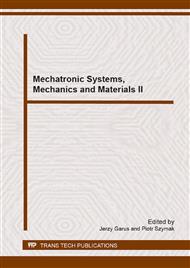[1]
Allianz Global Corporate & Specialty AG: Safety and Shipping 1912 -2012 From Titanic to Costa Concordia (2012).
Google Scholar
[2]
European Maritime Safety Agency: Annual Report (2011).
Google Scholar
[3]
Maritime Knowledge Centre, International Maritime Organization: International Shipping Facts and Figures – Information Resources on Trade, Safety, Security, Environment (2012).
Google Scholar
[4]
A.M. Rothblum: Human Error and Marine Safety, in US Coastguard Research and Development Centre, pp.1-10 (2000).
Google Scholar
[5]
A.M. Rothblum: Keys to successful incident inquiry, in Human Factors in Incident Investigation and Analysis, 2nd International Workshop on Human Factors in Offshore Operations (HFW2002), Houston, TX (2002).
Google Scholar
[6]
J. Lisowski: The Dynamic Game Models of Safe Navigation, TransNav - International Journal of Marine Navigation and Safety of Sea Transportation, Vol. 1, No. 1, pp.11-18 (2007).
DOI: 10.12716/1001.12.03.11
Google Scholar
[7]
J. Lisowski: Computational intelligence methods in the safe ship control process, Polish Maritime Research, No. 1, Vol. 8, pp.18-24 (2001).
Google Scholar
[8]
J. Lisowski: Game control methods in avoidance of ships collisions, Polish Maritime Research, Vol. 19, No74, pp.3-10 (2012).
DOI: 10.2478/v10012-012-0016-4
Google Scholar
[9]
R. Śmierzchalski, Z. Michalewicz: Path Planning in Dynamic Environments, Innovations in Robot Mobility and Control , pp.135-153 (2005).
DOI: 10.1007/10992388_4
Google Scholar
[10]
Ch. Tam, R. Bucknall: Path-planning algorithm for ships in close-range encounters, Journal of Marine Science and Technology, Vol. 15, Issue 4, pp.395-407 (2010).
DOI: 10.1007/s00773-010-0094-x
Google Scholar
[11]
S. Campbell, Naeem W., G.W. Irwin: A Review on Improving the Autonomy of Unmanned Surface Vehicles through Intelligent Collision Avoidance Manoeuvres, IFAC Journal of Annual Reviews in Control, Vol. 36, Issue 2, pp.267-283 (2012).
DOI: 10.1016/j.arcontrol.2012.09.008
Google Scholar
[12]
D. D. Guzman, S. Dellosa, P. Inventado, P. Lao, M. Suarez: A*Path Planning in Real-time Dynamic Environments, Proceedings of the 5th Philippine Computing Science Congress, pp.186-189 (2005).
Google Scholar
[13]
J. -H. Ahn, K. -P. Rhee, Y. -J. You: A study on the collision avoidance of a ship using neural networks and fuzzy logic, Applied Ocean Research, Vol. 37, p.162–173 (2012).
DOI: 10.1016/j.apor.2012.05.008
Google Scholar
[14]
L. P. Perera, J.P. Carvalho, C. Guedes Soares: Fuzzy logic based decision making system for collision avoidance of ocean navigation under critical collision conditions, Journal of Marine Science and Technology, Vol. 16, No. 1, pp.84-99 (2011).
DOI: 10.1007/s00773-010-0106-x
Google Scholar
[15]
J. Lisowski, M.M. Seghir: The safe ship control with minimum risk of collision, Transactions on Ecology and the Environment, Vol. 24, WIT Press (1998).
Google Scholar
[16]
Z. Pietrzykowski: Ship's Fuzzy Domain - a Criterion for Navigational Safety in Narrow Fairways, Journal of Navigation, pp.499-514 (2008).
DOI: 10.1017/s0373463308004682
Google Scholar
[17]
E. M. Goodwin: A Statistical Study of Ship Domains, Journal of Navigation, 28, pp.328-344 (1975).
Google Scholar
[18]
J. Lisowski, A. Rak, W. Czechowicz: Neural network classifier for ship domain assessment, Mathematics and Computers in simulation 51, pp.399-406 (2000).
DOI: 10.1016/s0378-4754(99)00132-9
Google Scholar
[19]
R. Szłapczyński: Evolutionary Sets of Cooperating Trajectories in multi-Ship Encounter Situations - Use Cases, TransNav - International Journal of Marine Navigation and Safety of Sea Transportation, Vol. 4, No 2, pp.191-196 (2010).
DOI: 10.1201/9780203869345.ch77
Google Scholar
[20]
M. -Ch. Tsou, Ch. -K. Hsueh: The Study of Ship Collision Avoidance Route Planning by Ant Colony Algorithm, Journal of Marine Science and Technology, Vol. 18, No. 5, pp.746-756 (2010).
DOI: 10.51400/2709-6998.1929
Google Scholar
[21]
M. Dorigo, M. Montes de Oca, S. Oliveira., T. Stützle 2011: Ant Colony Optimization , in J. J. Cochran, editor, Wiley Encyclopedia of Operations Research and Management Science, pp.114-125, John Wiley & Sons (2011).
DOI: 10.1002/9780470400531.eorms0030
Google Scholar
[22]
R. Śmierzchalski: An Evolutionary Method of Ship's Trajectory Planning, Electrotechnical Review, No. 4, pp.358-362 (2004).
Google Scholar
[23]
J. Lisowski, A. Lazarowska: The radar data transmission to computer support system of ship safety, Solid State Phenomena, Vol. 196, pp.95-101, Trans Tech Publications, Switzerland (2013).
DOI: 10.4028/www.scientific.net/ssp.196.95
Google Scholar
[24]
A. Lazarowska: Decision support system for collision avoidance at sea, Polish Maritime Research, Vol. 19, No 74, pp.19-24 (2012).
DOI: 10.2478/v10012-012-0018-2
Google Scholar
[25]
M. Dorigo, T. Stützle: The Ant Colony Optimization Metaheuristic: Algorithms, Applications, and Advances, Handbook of Metaheuristics, International Series in Operations Research & Management Science, Vol. 57, pp.250-285 (2003).
DOI: 10.1007/0-306-48056-5_9
Google Scholar
[26]
M. Dorigo, T. Stützle: Ant Colony Optimization: Overview and Recent Advances, in M. Gendreau and J. -Y. Potvin, editors, Handbook of Metaheuristics, volume 146 of International Series in Operations Research & Management Science, chapter 8, pp.227-263. Springer, New York (2010).
DOI: 10.1007/978-1-4419-1665-5_8
Google Scholar
[27]
A. Lazarowska: Application of Ant Colony Optimization in Ship's Navigational Decision Support System, in Marine Navigation and Safety of Sea Transportation: Navigational Problems, CRC Press, p.53–62 (2013).
DOI: 10.1201/b14962-12
Google Scholar
[28]
A. Lazarowska: Ant algorithms for ship route planning, Scientific Journals Gdynia Maritime University, No. 78, pp.43-52 (2013).
Google Scholar
[29]
A. N. Cockcroft, J.N.F. Lameijer: A Guide to the Collision Avoidance Rules, Butterworth-Heinemann Ltd (2012).
Google Scholar
[30]
Z. Pietrzykowski, P. Borkowski, P. Wołejsza: NAVDEC – navigational decision support system on a sea-going vessel, Scientific Journals of Szczecin Maritime University, No. 30 , pp.102-108 (2012).
Google Scholar


